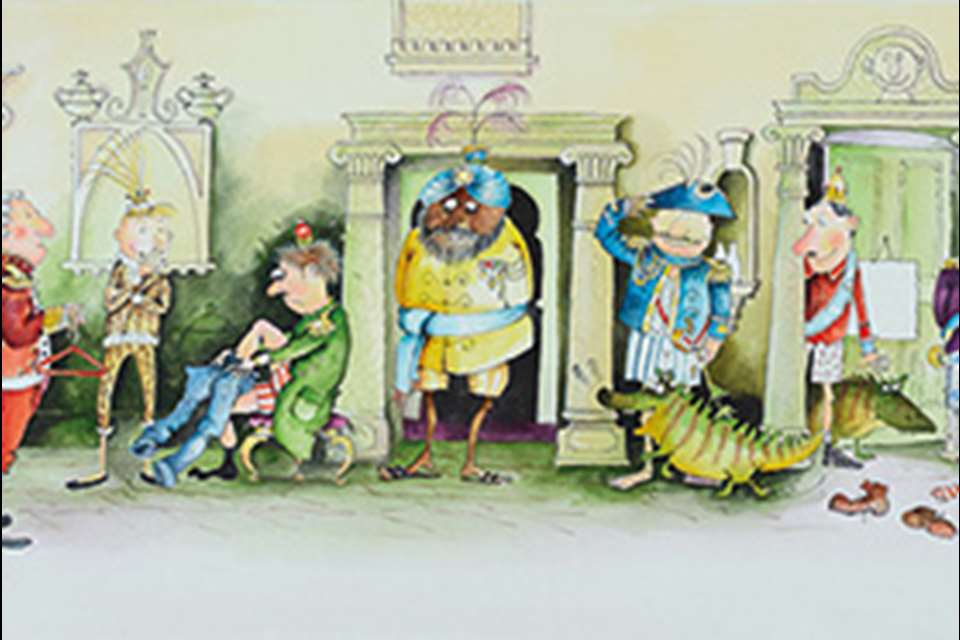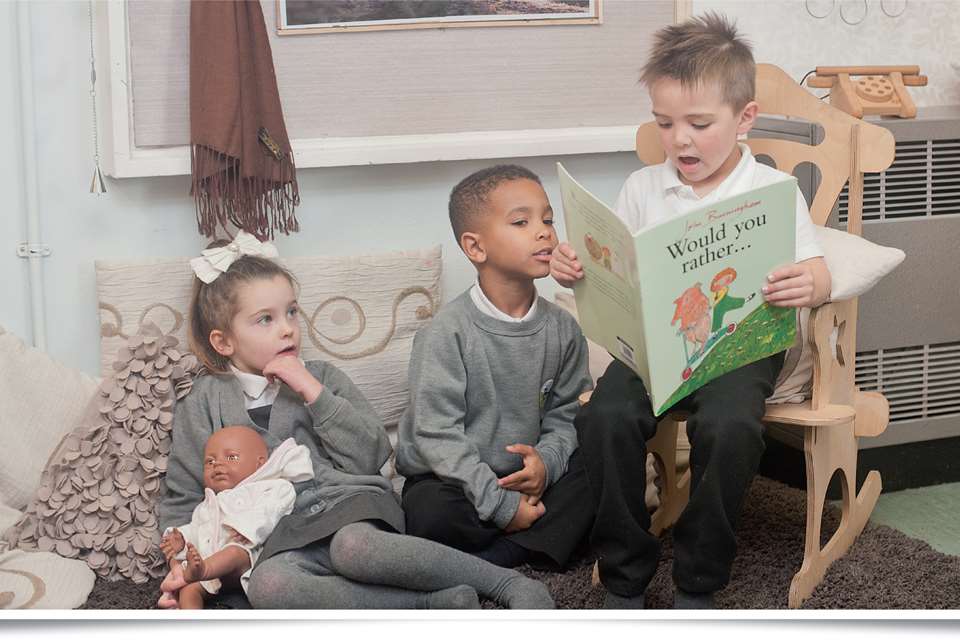Picturebooks, Part 1 - Not a word!
Andy McCormack
Monday, January 6, 2020
Can ‘silent’ picturebooks speak a thousand words, asks Andy McCormack

Silent’, or ‘wordless’, picturebooks are stories told only through pictures. Some author/artists who create them, such as the Australian Shaun Tan and the American David Wiesner, design their award-winning wordless picturebooks to appeal to readers of all ages, finding the form to be a particularly powerful one for exploring challenging and emotional themes.
Wordless picturebooks are having a particular cultural moment, being recognised for their potential as beautiful and sophisticated texts which offer stimulation to readers of all ages, backgrounds and cultures. They may be more familiar in the nursery than in the home, but they are beginning to make waves in the wider literary world.
We live in an increasingly visual culture, where we are challenged constantly to make sense of the images around us: billboards, advertisements, newspaper splashes and memes rely heavily on images, and are just as deserving of our critique as the taglines or headlines beneath them.
Spending time with wordless picturebooks in the nursery, talking and thinking about the decisions made by the author/artist and exploring potential meanings or interpretations with young readers are as important in the process of truly learning to read as decoding the text that traditionally accompanies them.

Aaron Becker's wordless picturebook Journey
WHERE ARE THEY USED?
The International Board on Books for Young People (IBBY) has pioneered the use of silent picturebooks in environments in which teachers and children might not share languages, particularly communities welcoming refugees. One of the great affordances of pictures, of course, is that they can be experienced by anyone: wordless picturebooks remove the pressures of even a few words written in unknown alphabets, making them universal and accessible for children from all backgrounds.
In 2012, IBBY developed a special collection of wordless picturebooks for a library on the Italian island of Lampedusa, which played host to refugees arriving in Europe from Africa and the Middle East. The project was replicated in 2013, 2015 and 2017, and the collections have been exhibited around the world to inspire teachers and caregivers working in communities challenged and enriched by diversity in language and culture.
IBBY Italia has produced a list of ten tips ‘for reading silent books in a community that does not speak a common language’, and IBBY Sweden has a useful guidebook for working with silent picturebooks and children (see More information). The overarching potential of picturebooks that IBBY summarises is a calming and peaceful shared reading experience: one quite different from the perhaps frantic nature of one-to-one reading in Reception, or the more rambunctious experience of sharing rhyming or interactive picturebooks at nursery storytime.
‘Be open to what the participants say, let them say what they need to say’, advises IBBY Sweden. ‘You’ll be surprised by the presence and concentration that can occur… Sometimes the session leaves behind a sense of peace and calm, while also being concrete and anchored in the experience.’
HOW ARE THEY USED?
Wordless picturebooks have been selected to form the core of a large research project, led by the University of Cambridge with nine other academic partners and funded by the EU, to ‘develop a Cultural Literacy Learning Programme, where young people of all ages learn the skills of dialogue and argumentation to be better able to communicate with each other, understanding each other’s perspectives and exploring the different cultural heritages and values of people who live in Europe. Dialogue that is characterised by collaboration encourages young people to think together as they express their opinions while listening to, and respecting, the opinions of others.’
It is telling that the DIALLS project (Dialogue and Argumentation for cultural Literacy Learning in Schools) selected the wordless picturebook to form the core of its research, providing stimulus for discussion among child participants, and a resource for teachers and researchers to collate, share and analyse.
DIALLS has produced a bibliography of more than 100 cultural texts and plans to publish open-access resources for teachers to use these wordless picturebooks ‘in their planning for the development of cultural literacy knowledge, skills and competences’ (see More information).
HOW CAN I USE THEM?
Before my own discovery of the potential of wordless picturebooks, I had encountered them as the first ‘branch’ or set of readers in the old Biff, Chip and Kipper Oxford Reading Tree series. Their inclusion there was important in making me think about how we experience books as physical and cultural objects: looking after them carefully, sharing them, and talking and thinking about them together. There is more to a book, and more to reading, than just an understanding of the words.
Use wordless picturebooks throughout the year, first in introducing new readers to the book-as-object, and later to remind developing readers to enjoy the book-as-object: read the pictures, discuss what they suggest and share the reading experience.
Too many of my Reception children were keen to race through readers to prove their burgeoning phonic knowledge. While this can be a great step in the process of developing enthusiastic literacy, we must be careful that one of the most important points of that literacy, to savour and enjoy as well as learn from the written word (and image), is not being lost.
Wordless picturebooks lend themselves particularly well to one-to-one and small-group reading, allowing for lots of rich discussion and engagement with what story the pictures might suggest – perhaps one different to every reader. They can, and should, be used for whole-class storytimes too, as they promote enriching ‘talk to your partner’ discussions and confidence-building opportunities for children to voice their thoughts and opinions even more effectively than stories read aloud and dictated solely by the teacher.

Footpath Flowers by Jon Arno Lawson and Sydney Smith
WHAT DO CHILDREN LEARN FROM THEM?
Wordless picturebooks promote literacy in a number of ways, not least that they can be read over and over again and never tell the same story twice. They rely on imagination and engagement with visual and narratively contextual clues, and are fantastic tools for developing the confidence of visual learners who might be struggling with phonic decoding.
It is especially important for these learners that teachers foster a love of reading in all its myriad forms, without prioritising and focusing all of their, and their pupils’, attention on one ‘right’ way of reading. Rich and complex books needn’t be mined for meaning solely via the words set down in text; rather, they can be experienced and interpreted via illustration in many different ways.
Wordless picturebook expert and researcher Evangelia Iordanaki describes children’s engagement with wordless picturebooks as a ‘dynamic process shaped by four factors: visual decoding, expectations, emotions, and context’. The ‘special nature and complexity’ of wordless picturebooks allow for ‘children’s narrative and cultural expectations’ to be ‘either reinforced or challenged by their reading of wordless books’, and require ‘the reader’s active engagement, for each reader uses visual decoding skills and culturally orientated knowledge in an effort to resolve the ambiguities of the pictures in a wordless story’.
Practitioners thinking of sharing wordless picturebooks with young children need to view these books as active, dynamic and culturally, developmentally and linguistically sophisticated, for only then will the children, in turn, value the potential of this exciting form of picturebook.
Although it is perhaps initially counterintuitive to think of the wordless picturebook as an important tool in developing literacy in the early years setting, the irony of a picturebook that speaks no words lies in the thousands it can generate in response. How many conversations can you start in your setting with a library of wordless picturebooks?
Top ten
I’ve selected a list of ten inspiring titles which should be readily available in the UK to get your collection started:
 Bounce, Bounce by Brian Fitzgerald
Bounce, Bounce by Brian Fitzgerald
 Owl Bat, Bat Owl by Marie-Louise Fitzpatrick
Owl Bat, Bat Owl by Marie-Louise Fitzpatrick
- Professional Crocodile by Giovanna Zoboli and Mariachiara Di Giorgio

 Lines by Suzy Lee
Lines by Suzy Lee
 Journey, Quest and Return (trilogy) by Aaron Becker
Journey, Quest and Return (trilogy) by Aaron Becker
 Free the Lines by Clayton Junior
Free the Lines by Clayton Junior
 Dog on a Digger by Kate Prendergast
Dog on a Digger by Kate Prendergast
 Footpath Flowers by Jon Arno Lawson and Sydney Smith
Footpath Flowers by Jon Arno Lawson and Sydney Smith
 Foxly’s Feast by Owen Davy
Foxly’s Feast by Owen Davy
 Here I Am by Patti Kim and Sonia Sánchez
Here I Am by Patti Kim and Sonia Sánchez
MORE INFORMATION
- Browsing reading lists collated by IBBY and DIALLS is well worth the time: what texts and titles will best benefit your setting?
- IBBY’s ‘Project Lampedusa’ reading lists and resources: www.ibby.org/awards-activities/activities/silent-books
- The DIALLS project reading lists and resources: https://dialls2020.eu/about
- BookTrust’s reading lists and resources: www.booktrust.org.uk/booklists/w/wordless-picture-books-for-children
Andy McCormack is an early years teacher studying for his PhD at the Centre for Research in Children’s Literature, University of Cambridge
Download Now





